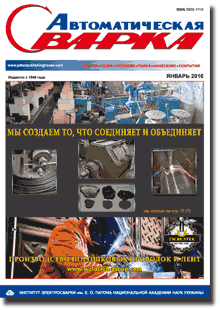| 2016 №01 (06) |
DOI of Article 10.15407/as2016.01.07 |
2016 №01 (08) |

Avtomaticheskaya Svarka (Automatic Welding), #1, 2016, pp. 47-52
Electron beam weldability of damage-tolerant titanium alloy TC21
Yuan Hong, Zhang Guo-Dong, Wang Jin-Xue, Yu Huai And Zhu Zhi-Shou
Beijing Institute of Aeronautical Materials 100095, Beijing, China. E-mail: hong.yuan@biam.ac.cn
Abstract
In China TC21 alloy represents itself α + β titanium alloys with tensile strength of 1100 MPa, high fracture toughness and low fatigue crack growth rate. The study of EBW of thick-section TC21 alloy was carried out and mechanical properties of welded joints were evaluated. Testing of fracture toughness and resistance to fatigue crack reveal that their damage tolerance is comparable to that of base metal. The high cycle fatigue strength of the EB-welded joints is 643 MPa, reaching 98.3 % of that of base metal. The microstructure of weld metal consists of coarse columnar dendritic prior β-grains and finer acicular ?-martensite, which accounts for the difference of crack growth rate and fracture toughness between base metal and metal of welded joints. These results indicate that TC21 titanium alloy has excellent EB weldability. 8 Ref., 1 Table, 9 Figures.
Keywords: electron beam welding, damage tolerance, fracture toughness, fatigue crack propagation
Received: 26.11.15
Published: 15.03.16
References
- Ji-kui Zhang, Xiao-quan Cheng, Zheng-neng Li (2010) Total fatigue life prediction for Ti-alloys airframe structure based on durability and damage-tolerant design concept. Materials and Design, 31, 4329–4335. https://doi.org/10.1016/j.matdes.2010.03.052
- Zhi-shou Zhu, Xin-nan Wang, Lu Tong et al. (2010) Research and application of damage tolerance titanium alloys for aeronautical use. Materials China, 29(5), 14–17.
- Chun-xiao Cao (2002) Change of material selection criterion and development of high damage-tolerant titanium alloy. Acta Metallurg. Sinica, 38, 4–11.
- Schiller, S., Heisig, U., Panzer, S. (1982) Electron beam technology, 315–318. John Wiley Publ.
- Xin-nan Wang, Zhi-shou Zhu, Lu Tong et al. (2008) The influence of forging processing on fatigue crack propagation rate of damage-tolerant titanium alloy. Rare Metals Letters, 27(7), 12–16.
- Nakajima, K., Terao, K., Miyata, T. (1998) The effect of microstructure on fatigue crack propagation of ? + ? titanium alloys in-situ observation of short fatigue crack growth. Materials Sci. and Eng. A, 243(1/2), 176–181. https://doi.org/10.1016/S0921-5093(97)00797-1
- Xiong, Y., Hu, X.X. (2012) The effect of microstructures on fatigue crack growth in Q345 steel welded joint. Fatigue & Fracture of Eng. Mater. & Structures, 35(6), 500–512. https://doi.org/10.1111/j.1460-2695.2011.01640.x
- Leyens, C., Peters, M. (2003) Titanium and titanium alloys, 160–161. John Wiley Publ.
